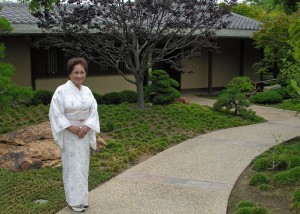Japanese Friendship Garden: Elegant Simplicity, Quiet Beauty
Expansion project ‘our gift to the citizens of San Diego’

By Delle Willett
A garden is always in a state of change and Balboa Park’s Japanese Friendship Garden is no exception. The Garden is in its initial expansion phase, adding nine acres in Gold Gulch Canyon, between the current garden and the House of Hospitality. This addition to the existing two-acre site will be completed in 2014, one year before the Park’s 2015 Centennial celebration.
Named San-kei-En— the Three Scene Garden: water, pastoral, and mountains—the Japanese Friendship Garden is designed to present an atmosphere of elegant simplicity and quiet beauty. Representing a new concept in the development of a Japanese garden outside of Japan, the design is guided by the original principles of the Japanese garden while incorporating elements of the regional landscape and climate, as well as sustainable practices throughout.
The Garden’s original master plan design was prepared in 1982 by the architectural firm of Fong and La Rocca, with Takeo Uesugi, FASLA, as the landscape architect. From 2001 to the present, Uesugi conceptually designed the remaining nine acres, continuing his 30-year association with the Garden.
The essence of a Japanese-style garden is the careful arrangement of stones, water, plants, and trees within a specific location. In response to the dramatic configuration of the Friendship Garden site, “Takeo Uesugi has combined these basic elements to create a peaceful, harmonious and transcendental environment conducive to meditation, enjoyment and enrichment,” explained landscape architect and board president Dennis Otsuji.
The expansion will include a camellia and azalea garden, a traditional tea house, a cherry tree grove, and tea and herb garden. A pavilion and amphitheatre will serve as a special-events venue. The pavilion, surrounded by a lotus pond, will hold 300 guests for events.
Meandering, accessible paths will originate at the south gate and wind down through the upper to the lower gardens. Along the way will be frequent resting areas with ever-changing views of the Garden. From several decks on the upper level visitors will enjoy spectacular views of the continuous blooms, dynamic water features and tranquil lotus pond. In the meantime, a public-view area located along Pan American Way allows visitors to Balboa Park a panoramic view of the expansion activities.
“The design has universal appeal for all visitors with multiple opportunities for personal renewal as well as social, educational, and private events,” said Otsuji.
Currently underway is construction of the main waterfall which meanders and falls from the highest point of the Garden. At this point will be undoubtedly the visitors’ favorite spot —a dragon bridge from which they can experience the vertical, rapid, and powerful water flow, which symbolically represents a dragon in the water. Their eyes will continue to follow the waterfall’s tributary streams that end at the main pond, surrounded with plantings of major tree specimens and an informal cherry tree grove.
The Japanese Friendship Garden has its roots in the park’s 1915 World Exposition with the Japanese Tea House Pavilion. After the Exposition the pavilion was presented as a gift to San Diego by Japan, and remained as a successful, vital attraction in Balboa Park until 1943.
The first two acres of the Garden opened in 1991; the second phase completed in 1999. The full 11-acre addition has been completely integrated in the master plan design by landscape architect Uesugi. Upon completion, the Garden will become one of the largest public Japanese-style gardens in the United States. It will also be the only garden in the U.S. with solar-powered energy.
A major cultural addition to Balboa Park incorporating the highest principles, values and traditions of the art of the Japanese garden, the Garden is an expression of friendship between San Diego and Yokohama that binds the two cultures to create a unique experience from visitors from all over the world—currently at about 125,000 a year, and projecting about 250,000 when the Garden is completed.
Explains Otsuji, “The Garden’s expansion project will be our gift to the citizens of San Diego. The main benefits fall into four general categories: to protect trees, wildlife, habitat and the environment; to preserve the rural character and scenic beauty of Balboa Park; to provide access to a wide range of horticultural and cultural educational programs and to increase tourism and bring revenues to San Diego.”
